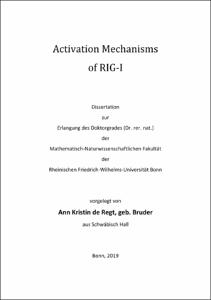de Regt, Ann Kristin: Activation Mechanisms of RIG-I. - Bonn, 2020. - Dissertation, Rheinische Friedrich-Wilhelms-Universität Bonn.
Online-Ausgabe in bonndoc: https://nbn-resolving.org/urn:nbn:de:hbz:5-58441
Online-Ausgabe in bonndoc: https://nbn-resolving.org/urn:nbn:de:hbz:5-58441
@phdthesis{handle:20.500.11811/8744,
urn: https://nbn-resolving.org/urn:nbn:de:hbz:5-58441,
author = {{Ann Kristin de Regt}},
title = {Activation Mechanisms of RIG-I},
school = {Rheinische Friedrich-Wilhelms-Universität Bonn},
year = 2020,
month = nov,
note = {Reliable and rapid elimination of viral infections is essential for all living organisms. RIG-I is a ubiquitously expressed innate immune receptor that is crucial for the detection of most RNA viruses. Upon binding of double-stranded (ds) RNA, RIG-I triggers an interferon (IFN) dominated antiviral immune response. Located in the cytoplasm, RIG-I is faced with the challenge of efficiently recognizing viral RNA without being activated by an excess of endogenous RNA. This thesis identified and investigated molecular interactions of the RIG-I C-terminal domain (CTD) with 5'end RNA modifications that render endogenous RNA non-immunogenic. Furthermore, immune activation by suboptimal, long and viral RNA ligands were studied to gain insights into RIG-I activation mechanisms.
This thesis discovered fundamental and within vertebrates highly conserved RNA modification-based mechanisms of immunotolerance towards potential endogenous RIG-I ligands. It therefore highlights the fine tuned balance between RIG-I sensitivity and selectivity for pathogenic RNA: Obviously, vertebrate organisms are not able to completely avoid the occurrence of endogenous RNA structures with short base-paired stretches leading to the requirement of additional immune regulatory RNA modifications.
The impairment of the RIG-I signaling pathway by PKR at high concentrations of long dsRNA indicates alternative and competing antiviral responses depending on the progression of an infection. Competing pathways have to be considered and, as shown in this thesis, can be avoided when designing synthetic RIG-I ligands for immune therapeutic applications.},
url = {https://hdl.handle.net/20.500.11811/8744}
}
urn: https://nbn-resolving.org/urn:nbn:de:hbz:5-58441,
author = {{Ann Kristin de Regt}},
title = {Activation Mechanisms of RIG-I},
school = {Rheinische Friedrich-Wilhelms-Universität Bonn},
year = 2020,
month = nov,
note = {Reliable and rapid elimination of viral infections is essential for all living organisms. RIG-I is a ubiquitously expressed innate immune receptor that is crucial for the detection of most RNA viruses. Upon binding of double-stranded (ds) RNA, RIG-I triggers an interferon (IFN) dominated antiviral immune response. Located in the cytoplasm, RIG-I is faced with the challenge of efficiently recognizing viral RNA without being activated by an excess of endogenous RNA. This thesis identified and investigated molecular interactions of the RIG-I C-terminal domain (CTD) with 5'end RNA modifications that render endogenous RNA non-immunogenic. Furthermore, immune activation by suboptimal, long and viral RNA ligands were studied to gain insights into RIG-I activation mechanisms.
This thesis discovered fundamental and within vertebrates highly conserved RNA modification-based mechanisms of immunotolerance towards potential endogenous RIG-I ligands. It therefore highlights the fine tuned balance between RIG-I sensitivity and selectivity for pathogenic RNA: Obviously, vertebrate organisms are not able to completely avoid the occurrence of endogenous RNA structures with short base-paired stretches leading to the requirement of additional immune regulatory RNA modifications.
The impairment of the RIG-I signaling pathway by PKR at high concentrations of long dsRNA indicates alternative and competing antiviral responses depending on the progression of an infection. Competing pathways have to be considered and, as shown in this thesis, can be avoided when designing synthetic RIG-I ligands for immune therapeutic applications.},
url = {https://hdl.handle.net/20.500.11811/8744}
}






